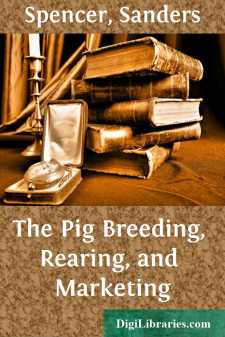Categories
- Antiques & Collectibles 13
- Architecture 36
- Art 48
- Bibles 22
- Biography & Autobiography 813
- Body, Mind & Spirit 142
- Business & Economics 28
- Children's Books 16
- Children's Fiction 13
- Computers 4
- Cooking 94
- Crafts & Hobbies 4
- Drama 346
- Education 46
- Family & Relationships 57
- Fiction 11829
- Games 19
- Gardening 17
- Health & Fitness 34
- History 1377
- House & Home 1
- Humor 147
- Juvenile Fiction 1873
- Juvenile Nonfiction 202
- Language Arts & Disciplines 88
- Law 16
- Literary Collections 686
- Literary Criticism 179
- Mathematics 13
- Medical 41
- Music 40
- Nature 179
- Non-Classifiable 1768
- Performing Arts 7
- Periodicals 1453
- Philosophy 64
- Photography 2
- Poetry 896
- Political Science 203
- Psychology 42
- Reference 154
- Religion 513
- Science 126
- Self-Help 84
- Social Science 81
- Sports & Recreation 34
- Study Aids 3
- Technology & Engineering 59
- Transportation 23
- Travel 463
- True Crime 29
The Pig Breeding, Rearing, and Marketing
by: Sanders Spencer
Description:
Excerpt
INTRODUCTION
There are few points in the breeding of stock on which a greater variation of opinion has been confidently expressed than on the origin of the domesticated pig. It has been contended that our various types had a common origin in the wild hog, and that the difference in form, colour, and character amongst the local breeds is due, in the main, to the requirements, imaginary or real, of the interested residents in the particular districts. On the other hand, it is asserted with equal confidence, and probably with the same amount of actual proof, that it would be impossible so to improve the wild hog by selection as to render it the equal of the domesticated hog. There must, therefore, have been an infusion of blood of a cultivated breed of pigs to acquire even that amount of success which was noticeable in the improved pig of a century, or less, ago. Unfortunately, for this argument, it has not been possible to obtain any information of value as to the alleged source of origin of this cultivated breed of pigs.
Again, those pigs which possess in a marked degree early maturity, fine quality of flesh, and those other characteristics of the improved pig, are so various in colour, that one cultivated breed only could not have been utilised in the general improvement.
All the ancient writers on pigs appear to have experienced the same difficulty when endeavouring to discover the sources of origin of the material which might have been used in the production of the pig which in their time was looked upon as the domesticated and improved pig of the period. This difficulty extends even to the present day. So far as is known there exists no actual proof that the domesticated hog has been evolved in any particular way other than by continued selection of those animals for breeding purposes which possessed in the greatest degree those particular qualities held in the highest estimation at the time.
Of course, the soil, climate, etc., of the district in which pigs are reared have a certain amount of influence, but this is noticeable to a much lesser extent with pigs than with horses, cattle, or sheep, since under the present system of pig-breeding the greater portion of the food used in the different districts is of a very similar character—indeed, much of it has a common origin—having been imported from abroad.
As a rule, comparatively speaking very little difference is noticeable in the development, form, and character of pigs bred in the various parts of the country, whereas with some of the other domesticated animals a very considerable change follows the removal of sheep of a pure breed from one district to another. The quality and quantity of the wool, flesh, and bone are all affected. An exactly similar effect is noticeable when horses of a particular breed are moved from one district to another. For instance, a Shire foal bred in the Fens may possess the characteristic bone, flesh, and hair, yet if it be moved into portions of the Eastern counties where the soil is of a totally different character, it will when matured have lost, to a very considerable extent, its peculiar characteristics of bone and hair....


